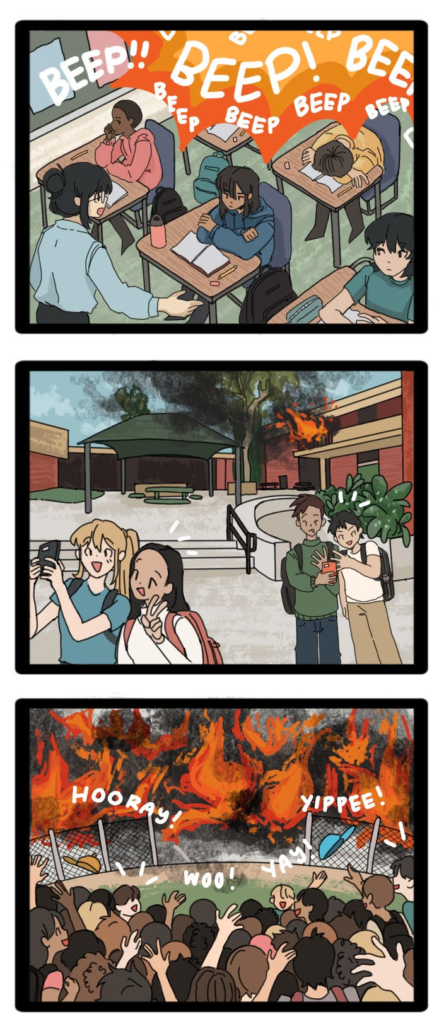ILLUSTRATION/ Allison Wei
By Tyler Lau
Staff Writer
The ringing fire alarm on Dec. 15 marked 52 false alarms just this month. Campus
supervisors and administrators rushed to their posts, bracing for an emergency, but the classroom
doors didn’t swing open with panic while the sirens echoed throughout the seemingly deserted
campus.
The frequency of false alarms has increased so dramatically that students and teachers
have become accustomed to tuning out the pulsating background noise, regarding it as an
aggravating hindrance. The rise of the viral internet trend #deviousflick encouraged students to
intentionally pull fire alarms for social media. The increase in on-campus smoking among
students caused smoke detectors to continuously pick up on the restroom antics. The excessive
smoking, along with the rise of the #deviousflick, caused the sirens to never stop blaring.
Students complained about how being attentive in class became almost impossible.
“My head throbs with migraines constantly,” junior Trieh Heard said. “I’m afraid that I
won’t pass the upcoming chemistry test. Ms. Joule’s boring, monotone voice blends in perfectly
with the sirens so that we can’t understand a word she says.”
The constant blaring clouded the minds of everyone, pounding their brains into a mushy
stew. Seeing students zoned out in classrooms was a regular sight, while others banged their
heads against the desks in a syncopated rhythm. As a result, the already sluggish and
sleep-deprived students were driven further into insanity.
On Dec. 19, the 100 and 200 buildings erupted in flames, slowly creeping across every
inch and to every corner of the school. Unresponsive to the ongoing sirens, students and teachers
didn’t evacuate until the flames crept into their classrooms through cracks in the walls and doors.
With their classroom now a fiery inferno of boredom and tiresome labor, students quickly took
the day’s BeReal by the flames before evacuating without any real concern or urgency. Students
leisurely strolled around the campus, taking in the smoke-filled, morning smog while enjoying
the flashy display of dancing lights. On the other hand, Trieh Heard, along with students in Ms.
Joule’s class, took their tests with laser-focus concentration while the room scorched and
combusted multiple chemicals.
The origin of the fire was later revealed to be the result of mishandled lighters, weed
cartridges and vapes in the school restrooms. The smokers spent most of their time clouding the
lavatories rather than learning in class. The large volume of nicotine in the smokers’ bodies
caused them to be in a constant state of panic and anxiety. As a result, the restroom dwellers
failed their classes and were held back multiple grades.
After the catastrophe, students were thankful for the spontaneous and much-needed break
from school, seeing as how the campus burned to the ground.
“I owe $9,000 in textbook damages,” Trieh Heard said. “Multiple admin workers rushed
out into the burning campus and risked their lives because I was finishing my chemistry test. But
the important thing is that I got the A.”
The students finally gathered at the Bob Hitchcock Stadium in their completely scattered
designated fourth period evacuation lines. Cheers and celebration broke out as the stress and
pressure of academic excellence lifted off the students’ overworked shoulders.
“All it took was just a few false alarms and one accident.” Rhonda Ram said. “I wish we
took the fire alarms seriously and stopped the smoking before it got out of hand.”

